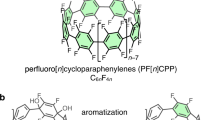Abstract
We report a facile synthesis of a [1,12-b,c,d]cyclopenta-fused perylene 5 from the parent perylene via a formylation-oxidative esterification–nucleophilic addition-followed-by-Friedel–Crafts alkylation strategy. Compared with the perylene, dye 5 exhibits much higher solubility, smaller energy gap, and can undergo regio-selective bromination at the peri-positions. Compared with the N-annulated perylene 8, compound 5 shows lower HOMO energy level and is more stable in air. Therefore, 5 can be regarded a new versatile building block for the development of high-order soluble and stable rylenes and various perylene-based functional materials.




Similar content being viewed by others
References
Herrmann A, Müllen K (2006) From industrial colorants to single photon sources and biolabels: the fascination and function of rylene dyes. Chem Lett 35:978–985
Chen L, Li C, Müllen K (2014) Beyond perylene diimides: synthesis, assembly and function of higher rylene chromophores. J Mater Chem C 2:1938–1956
Jiang W, Qian H, Li Y et al (2008) Heteroatom-annulated perylenes: practical synthesis, photophysical properties, and solid-state packing arrangement. J Org Chem C 73:7369–7372
Looker JJ (1972) Mononitration of perylene. Preparation and structure proof of the 1 and 3 isomers. J Org Chem 37:3379–3381
Sun YM, Tan L, Jiang SD et al (2007) High-performance transistor based on individual single-crystalline micrometer wire of perylo[1,12-b,c,d]thiophene. J Am Chem Soc 129:1882–1883
Luo J, Xu M, Li R et al (2014) N-Annulated perylene as an efficient electron donor for porphyrin-based dyes: enhanced light-harvesting ability and high-efficiency Co(II/III)-based dye-sensitized solar cells. J Am Chem Soc 136:265–272
Yao Z, Yan C, Zhang M et al (2014) N-Annulated perylene as a coplanar π-linker alternative to benzene as a low energy-gap, metal-free dye in sensitized solar cells. Adv Energy Mater 4:1400244
Qi QB, Wang XZ, Fan L et al (2015) N-Annulated perylene-based push–pull type sensitizers. Org Lett 17:724–727
Li Y, Wang Z (2009) Bis-N-annulated quaterrylene: an approach to processable graphene nanoribbons. Org Lett 11:1385–1388
Jiao C, Huang KW, Luo J et al (2009) Bis-N-annulated quaterrylenebis(dicarboximide) as a new soluble and stable near-infrared dye. Org Lett 11:4508–4511
Li Y, Gao J, Motta SD et al (2010) Tri-N-annulated hexarylene: an approach to well-defined graphene nanoribbons with large dipoles. J Am Chem Soc 132:4208–4213
Jiao C, Huang KW, Guan Z et al (2010) N-Annulated perylene fused porphyrins with enhanced near-IR absorption and emission. Org Lett 12:4046–4049
Jiao C, Huang KW, Wu J (2011) Perylene-fused BODIPY dye with near-IR absorption/emission and high photostability. Org Lett 13:632–635
Luo J, Lee S, Son M et al (2015) N-Annulated perylene-substituted and fused porphyrin dimers with intense near-infrared one-photon and two-photon absorption. Chem Eur J 21:3708–3715
Zeng Z, Ishida M, Zafra JL et al (2013) Pushing extended p-quinodimethanes to the limit: stable tetracyano-oligo(N-annulated perylene)quinodimethanes with tunable ground states. J Am Chem Soc 135:6363–6371
Zeng Z, Lee S, Zafra JL et al (2013) Tetracyanoquaterrylene and tetracyanohexarylene quinodimethanes with tunable ground states and strong near-infrared absorption. Angew Chem Int Ed 52:8561–8565
Zeng Z, Lee S, Zafra JL et al (2014) Turning on the biradical state of tetracyanoperylene and quaterrylenequinodimethanes by incorporation of additional thiophene rings. Chem Sci 5:3072–3080
Das S, Lee S, Son M et al (2014) para-Quinodimethane-bridged perylene dimers and pericondensed quaterrylenes: the effect of the fusion mode on the ground states and physical properties. Chem Eur J 20:11410–11420
Bair KW, Andrews CW, Tuttle RL et al (1991) 2-[(Arylmethyl)amino]-2-methyl-l,3-propanediol DNA intercalators. An examination of the effects of aromatic ring variation on antitumor activity and DNA binding. J Med Chem 34:1983–1990
Delany EG, Fagan CL, Gundala S et al (2013) NHC-catalysed aerobic aldehyde-esterifications with alcohols: no additives or cocatalysts required. Chem Commun 49:6510–6512
Zhao GJ, Han KL (2009) Excited state electronic structures and photochemistry of heterocyclic annulated perylene (HAP) materials tuned by heteroatoms: S, Se, N, O, C, Si, and B. J Phys Chem A 113:4788–4794
Berlman IB (1965) Handbook of fluorescence spectra of aromatic molecules. Academic Press, New York
Acknowledgments
This work was supported by MOE Tier 2 Grant (MOE2011-T2-2-130), A*STAR-DST joint Grant (IMRE/14-2C0239) and A*STAR JCO Grant (1431AFG100).
Conflict of interest
The authors declare that they have no conflict of interest.
Author information
Authors and Affiliations
Corresponding author
Electronic supplementary material
Below is the link to the electronic supplementary material.
About this article
Cite this article
Zeng, W., Qi, Q. & Wu, J. Cyclopenta-fused perylene: a new soluble, stable and functionalizable rylene building block. Sci. Bull. 60, 1266–1271 (2015). https://doi.org/10.1007/s11434-015-0839-3
Received:
Accepted:
Published:
Issue Date:
DOI: https://doi.org/10.1007/s11434-015-0839-3




